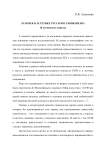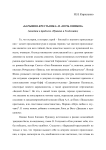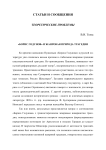Статьи журнала - Новый филологический вестник
Все статьи: 1746

The interaction between the individual and the state in Ayn Rand's novels
Статья научная
The theme of the interaction between the individual and a government is explored throughout the whole of Ayn Rand’s creative work - her three novels and seven books on the self-elaborated philosophy called Objectivism. The purpose of this study is to analyze the evolution of this theme in her novels in three perspectives. Firstly, as a development of different aspects of this interaction. In her first novel, We the Living, the Soviet state is depicted through the eyes of an 18-year old female character, who personally suffered from the October revolution. Hardships of the post-revolutionary life are enhanced by the permeating atmosphere of fear. Thus, it is the psychological aspect that comes to the fore. The second novel, The Fountainhead, focuses on the personality of the protagonist, and therefore, the ethical aspect of the relationship acquires more importance. In the last novel, Atlas Shrugged, the relationship between the individual and the government is revealed through the economic framework. Here the government is portrayed as robbing hard-working businessmen. Secondly, the development of the theme is analyzed as the reflection of the author’s philosophical views which were formed owing to her personal life experience under both social systems - socialism and capitalism. If in her first novel, her criticism is aimed at socialism, the target of her third novel is the capitalist society, which due to the interference of the state in the economy starts reminding of its counterpart. Thirdly, the study considers how this theme is treated artistically. Starting with the realistic method of unfolding the theme in We the Living, in her following novels Rand develops philosophical generalisation, thus distracting the novels’ content from a concrete reality. The enhancement of the philosophical aspect of her novels decreases, however, their artistic value.
Бесплатно

The narrative essay in Russian and Uzbek literature: lyro-epic vs lyro-dramatic
Статья научная
The notions of the lyro-epic and lyro-dramatic principle in prose can serve both as genre generalizations or as an indication of the convergence of different traditions within national literature, as well as the specification of national literature at a point of crisis of the novel genre. During the unprecedented events of the collapse of the Soviet Union and the new wave of postcolonial pursuits in world culture, the short story becomes a site not only of narrative but also of genre experimentation: it captures an ever-changing modernity, with the clash of narratives, qualities of inner speech and temporalities forming new configurations of combining epic, lyrical and dramatic moments in each story. This article uses the example of works by Russian (Jan Goltzman, Sergei Soloukh, etc.) and Uzbek (Shukur Xolmirzaev, Isajon Sulton, Muhammad Sharif, Ulugbek Hamdam) prose writers to show how the development of the lyric and epic element in Russian literature corresponds to the development of the lyric and dramatic element in Uzbek literature. The Russian story is largely dominated by simple allegory, which makes it possible to reduce the complex experience of the past to a set of successive affects. In the Uzbek story, complex allegory dominates, determining the relationship of plot twists and traditional images. It is traced in detail how the work of complex allegory determines the position of the author and the hero, the system of identifications and reactualization of national heritage in the global postcolonial context. The question is raised about the connection of this distribution of genre patterns with the principles of the organization of social life as well as the understanding of the subject of the speech. In Russian literature this subject is a person from the intelligentsia, who inherits the advances of Russian classical literature in depicting the inner world and the challenges of the present. In Uzbek literature this subject is a modern person in the broad sense, who knows how to find a common language with different social groups and who draws on tradition as a source of this common language, rather than of certain emotional experiences.
Бесплатно

Статья научная
This article attempts to analyze the artistic means by which two writers - William Faulkner and M.E. Saltykov-Shchedrin - in their novels written in the genre of the “genealogical saga”, are depicting the decay, degeneration and abolishment of a fading noble family. In addition to the natural signs of the degeneration of the noble family (such as drunkenness and in the case of Golovlyovs, the criminal sources of enrichment in the case of Sutpen, and the departure from the patriarchal canon in both cases), both writers also appeal to metaphysical reasons - in particular, such as the predestination of death, the initial doom of the noble family due to this or that sin, the “wormhole”. Faulkner and Shchedrin develop the metaphor of the noble estate as a mausoleum in which its inhabitants are imprisoned; coffin or tomb, where they rested during their lifetime; the image of the ice Dante’s hell embodied on earth in the world of a noble estate. These metaphors and images are reinforced by demonic features in the images of the main characters of the novels - Thomas Sutpen, Arina Petrovna, Iudushka, - reinforced by extensive parallelisms. Both writers create in their works a special text using all kinds of images: mythological, biblical, even fabulous; our task will be to trace their artistic identity. Moreover, as an additional task, we will try to identify the common places of the two novels and to prove that the “Golovliov Family” by M.E. SaltykovShchedrin could have influenced W. Faulkner and reflected on his artistic worldview during his work on the novel “Absalom, Absalom!”
Бесплатно

Статья научная
This article outlines the general patterns of introducing the elements of characters’ appearance into A. Bely’s novel “Petersburg”. The portrait details in the novel are generally analyzed from the standpoint of aesthetic and ideological peculiarities, however some general comments and conclusions presented in the works of the last decades point out the existence of certain controversies and the lack of any detailed analysis of the visual features of characters in the novel. The analysis, presented in this article, brings to light the particular features of the visualization of characters’ appearance and the functions of portrait detail in A. Bely’s novel “Petersburg”. The observations of Bely’s methods of introducing visual characteristics of characters in “Petersburg” lead to the following conclusions. For the entire text of this written work A. Bely does not refuse to portray characters’ external features, but the methods he uses to do it serve to deform and weaken the visual imagery. The construction of character images in “Petersburg” is defined by the lack of composure and thoroughness and the absence of the characterological function (the indications of the connection between external changes and internal processes), a tendency to on one hand accentuate certain body parts or facial features (eyes, back, etc.) and to highlight certain details while mixing the features of a character’s appearance and their surroundings and on the other hand introduce portrait details to inanimate objects (i.e. anthropomorphosis). Besides, it is clear that the notions and reference points that the theory of literature had offered before (the “portrait”, its function and various typologies) can only be applied to interpret the peculiarities of the “Petersburg” poetics only nominally.
Бесплатно

Статья научная
In contrast to Roman Ingarden’s well-known concept of the literary work as a stratified formation, the concept of the order of sequences in it has never attracted much attention. Therefore, the absence of this concept in neurophenomenology is not surprising, even though the founders of neurophenomenology have often drawn on the same Husserlian inspirations. Put together with their ideas, Ingarden’s concept still seems to be inspiring. Its strength lays in an in-depth analysis of temporal modes of understanding related to the sequential nature of language. This kind of analysis works also for memory mechanisms, which, according to Ingarden, function in a similar way. They are responsible for creating schematized aspects and integrating them into the experienced objects. Ingarden derived these schemes from Husserl’s concept of time-consciousness, and from the work of Bergson. The background of his ideas, however, were studies on memory performed by the philosophers from the Lvov-Warsaw School. Taking into account those three sources of inspiration makes it possible to offer a solution to the neurophenomenological problem of the cognitive value of the so-called protocols of first- and third person narratives, and fosters a better understanding of the narratological concepts of Russian, Prague, and Polish structuralists.
Бесплатно

Translingualism in the light of semiotics (“Maybe Esther” by Katja Petrowskaja)
Статья научная
Translingualism emerged during the 2000s as a new concept, alongside polylingualism and metrolingualism, that is clearly distinct from the guiding concept of multilingualism. The concept relativizes rigid connections between language, people and territory on the one hand, whilst also calling into question the notion of languages as closed and clearly distinguishable units. It is predicated upon “dynamic bilingualism”, whereby the languages involved each represent their own respective system. Trans-lingualism thus brings a new aspect of linguistic reflexion into play. Thus understood, translingualism will be explicated in relation to Katja Petrowskaja’s novel. The German author of Ukrainian extraction was awarded the Ingeborg-Bachmann-Prize in 2014 for her debut work “Maybe Esther” in which she describes, in a language that is foreign to her, the story of her family during the World War II, in the course of which a number of her Jewish relatives were murdered. For the purposes of the current paper, the prime interest is not the content of this quite typical 20th century story, but its linguistic conception. Petrowskaja is a professional philologist who graduated from the University of Tartu and its renowned semiotic school led by Jurij Lotman and Boris Uspenskij. Her text is deliberately constructed according to semiotic principles and can be read as a literary demonstration of Lotman and Uspenskij’s academic concepts. Behind the linguistic peculiarities, a hidden semiotic approach to language is evident, which regards language as a system of symbols. Translingualism in Petrowskaja’s writing, which purports to transcend linguistic boundaries by mixing languages and crossing over associatively from one language to the other, does not in fact dissolve linguistic boundaries. Rather, it activated reflexive processes across such boundaries. In the light of Lotman’s work on culture and cultural memory, Petrowskaja’s novel appears not only as a linguistic experiment but also, above all, as an experiment in engaging with diverse cultural codes. The translingual aspect illustrates the reflexion across apparently different and historically unconnected languages and cultures. On the other hand, the concept also contains a conscious denial of power structure associated with to the monolingualism of a national language.
Бесплатно

Статья научная
The article is devoted to the examination of the strategy of the famous literary critic of conservative stream Victor Petrovich Burenin (1841-1926) during his cooperation with the newspaper “Novoye Vremya” (New Times), published by A.S. Suvorin. The material for the study of the chief techniques used by Burenin and his position in relation to the “new art” of the turn of the 19th - 20th centuries is offered to consider the polemic which centered around D.S. Merezhkovsky’s public lecture “On the Reasons for the Decline and the New Trends in Contemporary Russian Literature”, published as a boo; in 1893. Typologization, including the grouping of the object of criticism into a series of names which in Burenin’s texts already have a certain semantic field assigned to them (for example, he compared Merezhkovsky to S.Ya. Nadson with his “claims” to be a “genius”, beyond the reach of both authors for him), are among the methods typical of Burenin’s strategy. This analysis of the polemical remarks (with the participation of another key contributor, Akim Volynsky) enables us to see a point of convergence that seems impossible for the opponents: the goal of the “truthfulness” of art, understood, however, in quite different ways by Burenin and his “cynical realism” and by Merezhkovsky. At the same time, in this context, an unexpected similarity emerges in their confrontation as spokesmen of different aesthetic positions. The presented review offers an insight into the participants of the polemic, not only in their own remarks, but also in their mutual reflections, which offers a broader perception of their positions.
Бесплатно

Valentin Rasputin аnd Uzbek literature: reassembling village prose as nation building
Статья научная
Reception of Valentin Rasputin’s prose can be traced in Uzbek literature at different levels: the plot (the situation of war and women’s loneliness; the gap between generations), the characters (the opposition of tradition and modern people), ideas (adaptation of philosophical and ethical concepts of moral judgment and moral immortality) and the main conflict (an integral personality as rooted in tradition vs. a damaged personality as devoid of roots), which can unfold within an individual hero. However, the contrast between the village and the city is replaced here by the contrast between the generic as traditional and the individual as a threatening break with the ancestors and the disappearance of historical memory. If for Rasputin the village remained a place of moral patterns of behavior, albeit partially destroyed by modernization, and public discussion was to limit the effects of modernization, then in Uzbek prose, which consciously reassembles Rasputin’s plots, the reality of the village (kishlak) and the city is dependent on the reality of the home, as only space of conflict. The Uzbek writers do not consider modernization as a main threat, but rather the loss of ancestral memory, depicting the situation not in a dramatic way, but in a tragic way, as an internal conflict within an individual. We cite numerous examples to show how the symbols, images, and plot developments invented under the possible influence of Rasputin take on a philosophical rather than a social meaning. By doing so, the Uzbek literature should have rather affirmed the mission of the writer as a prophet capable of linking the idea of personality and the idea of generic memory, and thereby brought the discussion to the level of a general theory of personality and the general fate of Uzbekistan as an independent cultural world, in which the opposition of city and village is not so essential in comparison with a common national identity.
Бесплатно

Рецензия
В рецензии рассматривается монография Халины Вашкелевич, польской исследовательницы и переводчицы произведений Л. Петрушевской, которая практически не знакома русскому читателю, но может представлять для него большой интерес. Выявляется, что в качестве основных особенностей, организующих поэтику произведений Л. Петрушевской, автор рецензируемой книги выделяет многомерность, концентричность и ассиметричность. Реализация этих принципов прослеживается Х. Вашкелевич на протяжении всех семи разделов книги, посвященных разборам конкретных текстов. В рецензии особо отмечается мастерство автора книги при анализе деталей, а также обширная библиография, дополняющая исследование.
Бесплатно
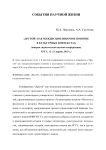
Статья обзорная
В статье представлен отчет о II научной конференции студентов и аспирантов «Другой как междисциплинарное понятие в культурных контекстах», прошедшей 12-13 марта 2010 года в Институте филологии и истории РГГУ.
Бесплатно

Статья научная
Данная статья посвящена теоретической рефлексии над эмблемой в XVII в. в рамках как «итальянской» группы академиков, обсуждавшей композиционные особенности жанра импрезы, ярчайшим представителем которых стал Эммануэле Тезауро, выдвинувший собственную концепцию сочинения эмблем; так и в рамках Общества Иисуса, которое активнейшим образом популяризовало книги эмблем в широких народных кругах, а также использовало их в педагогических целях при собственных школах. В данной статье большое внимание уделено становлению так называмой «философии изображений» XVII в., развившейся в рамках иезуитского сообщества, поддержанной такими его представителями, как К.Ф. Менестрие и Я. Мазен, чей историко-философский труд рассматривается с точки зрения эмблематики.
Бесплатно
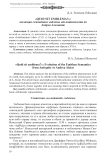
«Quid sit emblema?»: эволюция семантики эмблемы от античности до Андреа Альчиато
Статья научная
В данной статье эволюция феномена эмблемы рассматривается во всей ее полноте, от античности до ее перерождения в эпоху Возрождения в виде «Emblematum Liber» (1531 г.) Андреа Альчиато. Настоящая статья прослеживает и подчеркивает особую преемственность термина ренессансным гуманизмом, а также и античное понимание эмблемы, учитывавшееся Андреа Альчиато, наряду с теми новыми смыслами, которые она обрела в XVI в.
Бесплатно

Статья научная
В статье приведены основные результаты исследования корпуса стихотворений, созданных русскими поэтами (преимущественно ХХ века), при помощи программного комплекса «Гипертекстовый поиск слов-спутников в авторских текстах», который позволяет в автоматическом режиме выделить в корпусе повторяющиеся лексические комбинации. Под лексическими комбинациями понимаются переходящие из текста в текст скопления слов, не обязательно связанные между собой грамматическими и стиховыми связями. Предметом настоящего исследования стали лексические комбинации, включающие компонент «Армения» и однокоренные слова. В процессе исследования авторы статьи столкнулись с двумя типичными случаями. Первый - когда лексическая комбинация объединяет стихотворения разных авторов, но влияния одного текста на другой нет (С. Городецкий и Б. Чичибабин). Второй случай (В. Брюсов и С. Городецкий), когда лексическая комбинация маркирует два текста, анализ которых позволяет говорить о влиянии текста Брюсова на Городецкого. Применение программного комплекса позволило выявить ряд доминантных компонентов «армянских» лексических комбинаций, присутствующих в стихах русских поэтов («Арарат», «Ереван», «гора», «небо», «земля», «кровь», «сердце», «душа», «пламя», «вечный») и факультативных («враждебный», «истлевать», «близорукий», «книга», «ребенок», «Комитас» и др.). В ходе интерпретации лексических комбинаций были установлены текстовые «армянские» ассоциации разных авторов (В. Брюсов, С. Городецкий, О. Мандельштам, Б. Садовской, В. Звягинцева, М. Шагинян, М. Петровых, Б. Чичибабин, М. Дудина, Б. Слуцкий, М. Матусовский, И. Лиснянская и др.), а также установлены незафиксированные ранее в исследовательской литературе интертекстуальные связи.
Бесплатно
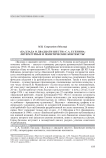
«Баллада о двадцати шести» C.А. Есенина: литературные и политические контексты
Статья научная
«Баллада о двадцати шести» – отклик С.А. Есенина на актуальное политическое событие – шестую годовщину расстрела руководителей Бакинской коммуны 1918 г. В дни, когда в Азербайджане вспоминали комиссаров, Есенин приехал в Баку по приглашению П.И. Чагина – второго секретаря ЦК КП Азербайджана, редактора газеты «Бакинский рабочий». Есенин соглашается написать стихотворение на злободневную тему и получает от Чагина большое количество материалов, характеризующих историю коммуны, содержащих биографические сведения о ее руководителях и воспоминания. Также в поле зрения Есенина – художественные произведения, посвященные деятелям коммуны, в том числе поэма В.В. Маяковского «Гулом восстаний, на эхо помноженным, об этом дадут настоящий стих, а я лишь то, что сегодня можно, скажу о деле 26-ти». Есенин работает очень быстро и результативно – в ночь с 20 на 21 сентября 1924 г. он пишет балладу, которая уже 22 сентября печатается в газете «Бакинский рабочий». Анализ публикаций 1922–1924 гг. позволил установить основные источники, которые Есенин использовал для получения информации о комиссарах и об обстоятельствах их гибели. Произведение посвящено «с любовью – прекрасному художнику Г. Якулову» – живописцу, графику и театральному художнику, одному из основателей имажинизма. В газете «Бакинский рабочий» был опубликован разработанный им эскиз памятника 26 комиссарам. Поэт упоминает только двух из них – С.Г. Шаумяна и П.А. Джапаридзе, основавших в 1906 г. газету «Бакинский рабочий» (их фамилии публиковались под шапкой издания). Для Есенина важно, что дело бакинских комиссаров, за защиту которого они заплатили своими жизнями, живо и увенчалось успехом. Герои баллады вступают в посмертный диалог, радуясь успехам советского Азербайджана.
Бесплатно

«Баллада о калмычке» М. Хонинова в аспекте синтеза жанров
Статья научная
В калмыцкой поэзии ХХ в. жанр поэмы занимал лидирующие позиции по сравнению с периферийным положением жанра баллады. Наряду с собственно балладой у калмыцких поэтов выявлен синтез жанров - баллады и поэмы - в творчестве М. Хонинова: «Баллада о битве с ветром» (1967). Предметом данного исследования является «Баллада о калмычке» (1979) М. Хонинова в аспекте синтеза жанров. Актуальность определяется недостаточной изученностью объекта исследования. Цель статьи - определить жанровую природу произведения, рассмотрев элементы жанровых образований, повлиявших на форму и содержание «Баллады о калмычке» как в оригинале, так и в русском переводе. Среди балладных признаков - исключительное событие трагического характера, героический сюжет, гибель трех главных героев, необычные сюжетные коллизии (беспалый младенец, спасение маленького наследника и др.), двоемирие (бесы), связь с фольклором и др. Большой объем (1579 строк) проецирует жанр поэмы: существенная роль фабулы, герой не только субъект изображения, но и его объект, акцентирование близости автору героя, вставные фольклорные элементы (колыбельная песня, благопожелание, сказание, сказки, пословицы), лирические отступления, портрет персонажа и др. Русский перевод поэмы-баллады характеризуется изменением названия и соответственно жанра (сказание), трансформированной строфикой, увеличением количества частей, сокращением объема (900 строк).
Бесплатно

«Беседы с памятью» В.Н. Муромцевой-Буниной: неизвестная книга о детстве и юности
Статья научная
Статья рассказывает о неизвестной книге В.Н. Муромцевой-Буниной, озаглавленной так же, как и известные воспоминания мемуаристки о совместной жизни с Буниным, - «Беседы с памятью». Эти более ранние «Беседы», которые планируется вскоре опубликовать в составе Полного собрания сочинений Муромцевой-Буниной, написаны под сильным влиянием идей и стилистики романа Бунина «Жизнь Арсеньева». Можно с уверенностью утверждать, что сам Бунин читал эти мемуары и на каком-то этапе выполнил стилистическую правку поверх текста жены. Книга полна чрезвычайно интересных сведений о жизни семьи Муромцевых в Москве рубежа XIX - XX вв. Круг знакомств родителей Веры Николаевны был весьма широк, поэтому ее воспоминания о днях детства и юности представляют собой широчайшую энциклопедию московской жизни. Еще более расширился круг общения Веры Муромцевой в юности: многие ее одноклассницы были девушками из известных семей, а в дальнейшем принимали активное участие в культурной жизни России и эмиграции. Учеба мемуаристки на Высших женских курсах тоже отразилась в книге: в эти годы она попала в круг студенческой молодежи и в вихрь предреволюционных настроений. Не менее интересны упоминания разного рода известных государственных, театральных, научных деятелей, которыми пестрят мемуары. Статья систематизирует дискурсы книги воспоминаний и анализирует внутреннюю структуру воспоминаний. А также сравнивает поэтику «Бесед с памятью» с поэтикой и идейной структурой «Жизни Арсеньева», фиксируя существенные совпадения.
Бесплатно

«Бортовой журнал» Арденго Соффичи как лирическая «Книга будущего»
Статья научная
Арденго Соффичи выбирает для своего программного автобиографического сочинения дневниковую форму. Исходя из структуры «Бортового журнала», можно заключить, что на протяжении одного года автор ведет запись, не пропуская ни одного дня. Соффичи включает в дневник фрагменты, написанные в разных жанрах и стилях. В нескольких записях «Бортового журнала» Соффичи предлагает свое видение «книг будущего». Согласно писателю, они должны включать автобиографию, психологические наблюдения, письма, а главное, лирические откровения. Все это содержится в его новом революционном произведении, призванном заменить собой устаревшие литературные модели. «Бортовой журнал» составляют афоризмы, выдержки из искусствоведческих исследований, письма, сатирические зарисовки, философские размышления, «мальтузианские» стихи, стихотворения, содержащие высокую лексику, и лирические фрагменты, выполненные в стилистике «prosa d’arte». «Бортовой журнал» Соффичи полностью вписывается в концепцию «новой литературы» журнала «Воче», одним из идеологов которой выступал сам писатель. Тем не менее Соффичи, покинувший «Воче» и заключивший союз с футуристами, стремится воспеть в своем программном произведении футуризм и его адептов. Нигилистический посыл и коллажность сочинения Соффичи, действительно, отвечают футуристической доктрине, и все же лирическая направленность «Бортового журнала» очень далека от положений теории Маринетти. Новое произведение Соффичи подвергается резкой критике «друзей-футуристов».
Бесплатно

